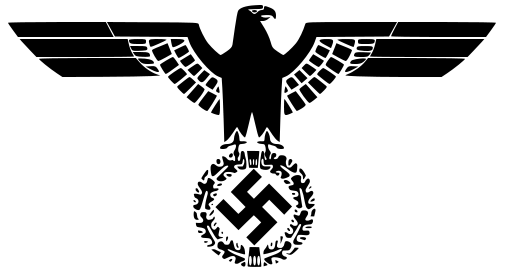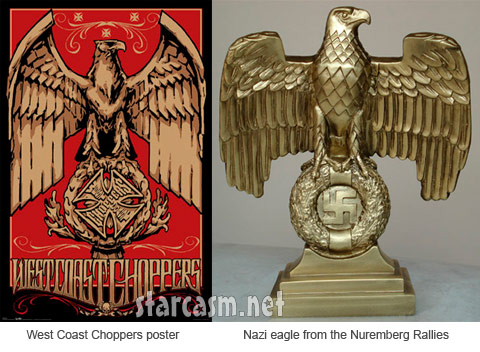Nazi symbolism
Supporters of international extreme right make use of certain symbols and signs to show their attitude in public. Like all symbols, they serve the fast recognition, so make a group and transnational code dar. Under German law, the public show of almost all right-wing extremist symbols or marks is according to § 86 of the Criminal Code ( dissemination of propaganda of unconstitutional organizations) and § 86a of the German Criminal Code ( use of symbols of unconstitutional organizations) punished.
After 1945 symbols and signs of the Nazi ideology of the German and international right-wing extremist scene resumed, reinterpreted for part and expanded, particularly in the 1990s by new abbreviations and symbols.
Species
This symbolic language includes not only slogans ( "Our honor is loyalty " ), the use of terms of Nazi terminology ( " Ostmark " ) and ciphers such as the " East Coast ( the USA)" for the supposedly by " the Jews " dominated politics and media landscape of the United States, " Central Germany " in a revisionist interpretation of terms such as the " fascism mace ", " Auschwitz club" or even simple calendrical data (see anniversaries ).
Abbreviations
The letters or numbers listed here have been established in the neo-Nazi scene and be used in this form, for example as non- criminal version of unconstitutional symbols or slogans. Find use these abbreviations for example, a print or a patch of clothing such as baseball caps, T-shirts, etc., or as a complement to signatures for texts, demonstration banners and flags, CD booklets or album covers, etc., to show one's own mind.
In addition, it also gives 1 = on, 4 = Germany, 8 = healing, 8 = Hitler stand.
Especially popular are combinations of the respective number of symbols such as 88/14 or 14 / 88th Right rock and NSBM CDs do not cost 14.88 euros rare in neo-Nazi acts shipping.
Stronger in the U.S. than in Europe, the following symbols are used:
Anniversaries
Symbolic content have several anniversaries, eg
- February 13 as a day of air raids on Dresden,
- April 20 as the birthday of Adolf Hitler,
- May 1 as introduced by the Nazis holiday,
- August 17 as the anniversary of Hitler's deputy Rudolf Hess in Spandau Prison
- November 9 as the date of the failed " Hitler Putsch " in 1923 and the " Kristallnacht " in 1938.
Clothing and Accessories
Garments that show the letters NSDAP ( Consdaple ) in the manufacturer's name or logo will be borne by the neo-Nazi scene like. For example, on shirts logo is positioned so that when open jacket only the acronym of the banned party NSDAP is visible. Clothing companies such as Lonsdale ( with open jacket are the letters NSDA to recognize ) or Fred Perry but distance themselves from such associations. More popular in the scene accessories are clean-shaven heads and garments of brands Thor Steinar and Harry North. Other well-known brands in this scene are Trouble Maker, Master Race Europe, Pit Bull and Rizist.
Flags
Demonstrations and marches of the neo-Nazi scene flags are often carried. Among the commonly encountered at such events include the following:
- Reichskriegsflagge: the imperial war flag, there were four versions in the years 1867-1945; punishable in the version of 1935-1945, the version of 1867-1921 is drawn in by the police, for example in Saxony on request. It was also used as a symbol of the National Collection ( NS).
- Black and white red flags, sometimes with the Iron Cross: The colors refer to the "Third Reich" in used by the Nazis colors. They stand in contrast to the colors black, red and gold, symbolizing the Federal Republic of Germany and is to be overcome by the extreme right. In addition, it enables without being under punishment, public Build on National Socialism.
- Germany flag: Although the colors black, red and gold of many right-wing extremists are rejected because they are both the national colors of rejected by the extreme right Weimar Republic and the Federal Republic of Germany. However, thus trying to catch up with the mainstream of society and to reach people who identify with the colors black, red and gold, but not right-wing extremists are. This is part of the normalization strategy of some right-wing extremists.
In addition, flags are supported by right-wing organizations (such as the NPD or the youth organization of the Young National Democrats ).
Graphical symbols
Wolfsangel vertical
Wolfsangel horizontal
Othala
Black Sun
Variation of Triskele
Many of the graphic symbols shown here are often used by right-wing extremists. Since they are often older ( Germanic or Celtic ) origin, some of them are, however, also used by non-political Goths or neo-pagans. Some Patches ( Gauwinkel ), others serve as jewelry ( pendants of necklaces, etc. ), and still others are used on posters, stickers and flyers. They are also worn as tattoos or sprayed, drawn and engraved. The described legal situation refers to Germany.
Gestures
- Nazi salute; punishable under. § 86a and § 130 of the Criminal Code.
- Kühn Greeting: also "Resistance Salute", modified version of the Hitler salute, is like this from the outstretched right arm, but stretched thumb, forefinger and middle finger and ring and small fingers are buckled. Named after the German neo-Nazi leader Michael Kuhnen; punishable under. § 86a and § 130 of the Criminal Code.
Network jargon
In network jargon of the neo-Nazi scene, the four will be read as Odal Rune Othala and used as identification.
Legal situation
The dissemination and use of symbols and slogans from the era of National Socialism and of banned neo-Nazi organizations in German criminal law applies as the use of symbols of unconstitutional organizations and according to § 86a StGB. However, often resorting to other, similar, but not banned license plates. The use of signs that do not fall under § 86a of the German Criminal Code, can be partially punished as sedition under § 130 of the Criminal Code.
In most countries, such as the USA, symbols of National Socialism may be worn in public.



.svg/200px-Parteiadler_der_Nationalsozialistische_Deutsche_Arbeiterpartei_(1933%2525E2%252580%2525931945).svg.png)






